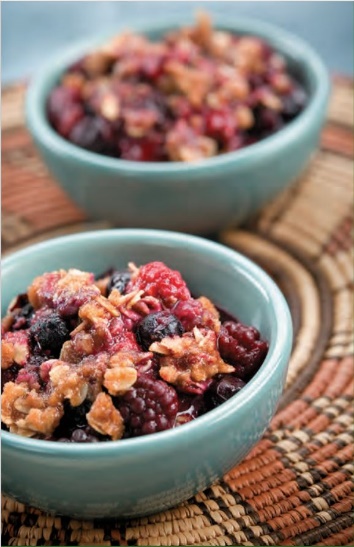In this edition
- Food for the Heart
- Heart Healthy Grocery Shopping Tips
- Heart Healthy Items to Add to Your Next Grocery List
- Mixed Berry Crisp
About the Newsletter
February's newsletter covers: heart health; grocery shopping tips; heart healthy shopping items to add to your next grocery list; and a high-fiber mixed berry crisp treat that provides heart health benefits.


Food for the Heart
Certain heart conditions disproportionately affect different races and ethnicities in the United States. High blood pressure (hypertension) in particular is much more prevalent in Black populations. According to the United States Census (2010-2019), Nevada has a Black population of 10.3% with high blood pressure affecting over 32% of that population. This trend continues for the nation, which may have you asking why race impacts heart health? The relationship may be related to genetics, environment and disparities in quality of medical care. However, there are nutritional ways every person can eat to support his or her heart.
Americans consume an average of 3,400 mg of sodium/day, yet the recommendation is 2,300 mg/day, and for those with hypertension it’s 1,500 mg/day. Believe it or not, the salt shaker on your dinner table is not the reason for Americans high intake of sodium, it is actually preprepared foods. When we eat out or purchase foods that are already premade, these meals tend to have more fat, sugar and salt than the same meal prepared at home. By cooking and preparing more of your food at home, you can control how much sodium you add to your meals. Start off slow, set a goal to replace one premade meal with one home-cooked meal.

Roxana Ehsani MS, RD, CSSD, LDN
Certain heart conditions disproportionately affect different races and ethnicities in the United States. High blood pressure (hypertension) in particular is much more prevalent in Black populations. According to the United States Census (2010-2019), Nevada has a Black population of 10.3% with high blood pressure affecting over 32% of that population. This trend continues for the nation, which may have you asking why race impacts heart health? The relationship may be related to genetics, environment and disparities in quality of medical care. However, there are nutritional ways every person can eat to support his or her heart.
Americans consume an average of 3,400 mg of sodium/day, yet the recommendation is 2,300 mg/day, and for those with hypertension it’s 1,500 mg/day. Believe it or not, the salt shaker on your dinner table is not the reason for Americans high intake of sodium, it is actually preprepared foods. When we eat out or purchase foods that are already premade, these meals tend to have more fat, sugar and salt than the same meal prepared at home. By cooking and preparing more of your food at home, you can control how much sodium you add to your meals. Start off slow, set a goal to replace one premade meal with one home-cooked meal.
When in the grocery store, look for no-salt added or reduced-sodium foods especially when shopping for canned products, stocks, soups, condiments, dressings, deli meats and cheeses. Instead of buying pre-seasoned meats and seafood, purchase these raw and add your own spices and herbs. Adding dried herbs and spices to food is a great way to add flavor to your meal without missing the salt.
Finally, don’t forgot about loading up on nutrient rich fruits and vegetables. Only one tenth of adults meet the recommended daily consumption of one and half cups to two cups of fruit per day and two to three cups of vegetables per day. Fruits and vegetables are loaded with vitamins, minerals, fiber and antioxidants. Instead of cutting out certain foods, consider adding more fruits and vegetables to meals and snacks that you are already enjoying each day. Try adding veggies to your morning eggs, toss baby spinach or frozen fruit into your favorite smoothie, or pack a piece of fruit and some cut up veggies for lunch or snack times. Small changes add up to big results especially when it comes to nourishing your heart and keeping your bl ood pressure within a healthy range.
Roxana Ehsani is a Las Vegas-based registered dietitian nutritionist, board certified sports dietitian and national media spokesperson for the Academy of Nutrition and Dietetics.
Heart Healthy Grocery Shopping Tips
Making better nutrition decisions to support a healthy heart starts by deciding what to eat, which often happens at the grocery store. Using the nutrition label when grocery shopping helps with choosing the best options to support our heart. The nutrition label provides a % Daily Value (DV) that estimates how much of a nutrient found in a serving of one food item contributes to your daily dietary needs for that nutrient. Generally, we want to look for:
- Lower % Daily Value (DV) in saturated fat, sodium, sugars added
- Higher % Daily Value (DV) in dietary fiber and potassium
Source: U.S. Food & Drug Administration. (2020). Food Labeling & Nutrition.
Here are some heart healthy grocery shopping items you can add to your next grocery list!
- Produce – pre-cut fruit and vegetables or pre-washed items can save on time
- Lean meats like boneless, skinless poultry; pork or steak loin cuts; flaky fish (e.g., tilapia and cod)
- Low-sodium deli meats – look for the phrases “no salt added” or “lower sodium” on packaging
- Whole grains (pasta, bread, rice, cereal) – aim for 5g of fiber or more per serving
- Low-sodium or no salt canned vegetables – if low-sodium options are not available, try draining and rinsing the product under water to remove some of the salt
- Canned fruit – look for options in 100% juice rather than syrup
- Canned meat like 98% fat free chicken, pink salmon or albacore tuna
- Herbs, seasonings, spices – using these can help reduce salt intake while keeping food flavorful
- Dairy products – look for reduced fat and no sugar added options
- Frozen produce and meat products – these items offer the same nutrients as their fresh counterparts -justmake sure the % DV of sodium is low
Provided by Macy Helm, UNR Extension Healthy Aging Community Educator
Mixed Berry Crisp

Mixed Berry Crisp
This high-fiber treat will tantalize your taste buds and offer heart-health benefits.
Ingredients:
- 7 cups frozen mixed berry medley thawed
- ½ tablespoon sugar
- 1 tablespoon all-purpose flour
- 1 ½ teaspoons cornstarch nonstick cooking spray
- ¾ cup of old fashioned oats
- ¼ cup whole wheat flour
- ¼ cup packed brown sugar
- ¼ teaspoon salt
- ¼ teaspoon cinnamon
- ¼ teaspoon vanilla extract
- 2 tablespoons chilled butter cut into small pieces
Directions:
- Place an oven rack in the middle of the oven. Preheat oven to 375°F.
- In a medium bowl, mix berries, sugar,all-purpose flour and cornstarch.
- Spray a 9 x 9-inch baking dish with nonstick cooking spray. Pour fruit mixture into the baking dish.
- In a medium bowl, combine oats, whole wheat flour, brown sugar, salt, cinnamon and vanilla extract. Mix in butter until crumbly.
- Sprinkle oat mixture evenly over berry mixture.
- Bake until topping is golden brown about 45 minutes. Serve warm or at room temperature.
For more recipes visit Soulful Recipes at www.CalFreshHealthyLiving.org.
An EEO/AA institution. This material was funded, in part, by USDA’s Supplemental Nutrition Assistance Program (SNAP), an equal opportunity provider.



